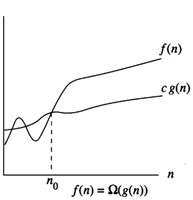Q, O, W and Asymptotic notation in equations
W notation: asymptotic lower bound
W g ((n)) = { f (n) : $ constants c1, n0 > 0 ' 0 £ c1 g (n)
£ f (n) " n ³ n0
 from Cormen figure 2.1 from Cormen figure 2.1
-
O ( g (n) ) is the top piece of bread
-
W ( g (n) ) is the bottom piece of break
-
in the Q ( g (n) ) sandwich
f (n) = Q ( g (n) ) Û f (n) = O ( g (n) ) and f (n) = W ( g (n) )
Thus "Big - Oh" is a bound on worst case, W is a bound (from below) on best case. For example in the case of insertion sort, for all inputs n:
T (n) = O (n2)
= W (n)
"Running time is W ( g (n) )" means that no matter what input the running time is at least c * g (n) for large n.
Anonymous functions
Recall that for Merge-Sort:
T (n) = 2 T (n/2) + Q ( n ) :: the Q ( n ) here is an anonymous function
the details are not wanted or needed, given an equation:
2 n2 + 3 n + 1 :: we write 2 n2 + Q ( n ) or Q ( n ) + some anonymous function of the order of theta of n.
|
|
has a single anonymous function |
In this example 2 n2 + 3 n + 1 = 2 n2 + Q ( n ) = Q ( n2 ) as 3 n + 1 is an anonymous function of n, and Q
( n2 ) overwhelms Q ( n ) as values of n become large.
"Little-Oh" Notation"
o ( g (n)) = { f (n) :: " c > 0 , $ n0 > 0 ' 0 £ f (n) £
c g (n) " n ³ n0
The big difference is for all c, thus this is and upper bound that is not tight. It also means that:
lim
n ® ¥ |
f (n) / g (n) = |
0 |
w Notation (w is to o as W is to O )
w ( g (n)) = { f (n) :: " c > 0 , $ n0 > 0 ' 0 £ c g
(n) £ f (n) " n ³ n0
lim
n ® ¥ |
f (n) / g (n) = |
¥ |
lim
n ® ¥ |
g (n) / f (n) = |
0 |
hence w f (n) = ( g (n) ) Û g (n) = o ( f (n) ) |







